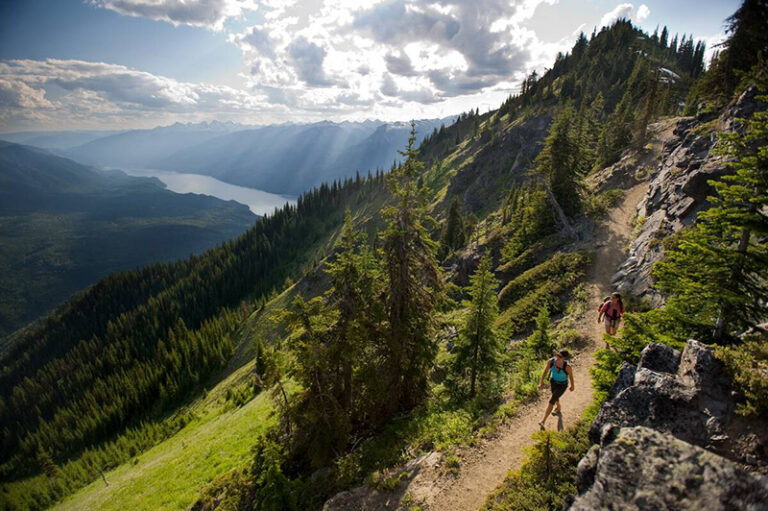The Winter Camping Handbook
Stephen Gorman
The Countryman Press, 2007, 224 pages.
The Winter Camping Handbook falls dead center in between Camping For Dummies and Freedom Of The Hills. On the one hand, an outdoorsman with a foggy recollection of Boy Scout preparedness could still siphon a good deal of knowledge from this book. On the other hand, a mountaineer with a few Cascade volcanoes notched in his ice axe won’t be reaching for this handbook often.
The book shines as a general summary on winter camping. Gorman quickly points out that this is a second edition, and primarily serves as a guide for wilderness travel in the cold weather months. He packed the book with more than a dozen overviews of critical winter camping logistics including trip planning, backcountry skiing and riding, camping with kids, cold weather injuries and even winter navigation. The detailed checklists and side notes are helpful and well done, while the pictures and artwork genuinely relate to each topic.
Sadly, the book only dedicates ten pages to avalanches, and five of those pages have large pictures. Even worse, there’s little mention and hardly any priority invested in the importance of the avalanche beacon. However, the fundamentals about every other piece of winter camping gear-from altimeters to toboggans-are sufficient.
Ultimately, it’s a great starting point for camping enthusiasts that might need some insightful directions on gearing up, planning a trip, or just an explanation about what to anticipate if you elect to spend a night out after a day of snowshoeing or backcountry skiing. Reading the book could easily prevent a dozen first-timer mistakes.
No doubt, winter camping has a special allure: the splendid quiet, the beauty of the crystal-white snow, the thrill of backcountry skiing or snowboarding, and all of it bug free. Living in the Northwest allows for spectacular access to hundreds of winter camping opportunities. Anyone interested in pursuing that special allure would do well to read The Winter Camping Handbook.
Jon Jonckers
Backcountry Betty: Roughing It in Style
Jennifer Worick
Mountaineers Books, 2007, 208 pages.
Backcountry Betty: Roughing It in Style by Jennifer Worick, sure is cute. Smaller than the average bear in paperback form, with rounded edges, the better to fit in your Prada knapsack. Snicker if you will, but I am serious about the pack-ability quotient of everything (except shoes of course). And therein lays Backcountry Betty’s downfall.
Brace yourselves girls, the author thanks her “Life Coach.” She also references the secret for staying positive about the whole messy endeavor. With four pages of how awful it is to have B.O., bad breath or gas-actual camping is the least of our troubles it would seem. Next she suggests you get a haircut and professional blowout the day before the trip, “…explaining to your stylist that you will probably be wearing a hat for a few days.”
The women I camp with are all Bettys because they like themselves and each other and the Great Outdoors. Camping is about getting out of one’s self, away from routine norms and habits. Under no circumstances is it okay to whip up hair and body masks out of food. Camping is not about embroidering adorable designs on your foul weather gear, checking with your local cheese expert for Fondue choices, or making a reservation at your favorite bistro for the day after your adventure to motivate you through it.
The author also suggests if possible, you bring an air mattress with “real bedding,” pillow sachets and festoon your lantern with stickers for that sexy glow. “Camptivate” his senses with vanilla on the camp stove, an iPod, and silky lingerie. One can also braid vines and create wind chimes with twine and bark to “beautify your campsite.” Don’t forget to feed your camp party guests mini grilled cheese and tuna melts. Serve Crystal Light cocktails, print the rules to card games, and make a big batch of Chex Mix before you leave home to share while playing Truth or Dare with your new best wilderness friends. And Ladies, when possible, walk with your hands over your heads to avoid “sausage fingers.”
You could avoid this book altogether and camp with sane women. But if you just gotta have it for your coffee table, then here is a free tip: rip out the useful last six pages of camping essentials, glossary of outdoor terms and wilderness resources guide. Use the rest to start a sexy fire.
Heather Swanstrom
On My Own Two Feet: The life of a Mountaineer
Norman Hardie
Canterbury University Press, 2006, 312 pages
On My Own Two Feet chronicles the life of a member of the first team to summit Mt. Kangchenjunga, Norman Hardie. Hardie’s autobiography not only illuminates a life writ large on its own account, but also serves as a backstory to many of the exploits of fellow New Zealander, Sir Edmund Hillary. Hardie and Hillary climbed together before Everest. Hardie helped engineer and climbed with the high altitude physiology “silver hut” research expedition to Ama Dablam, assisted Hillary in the Antarctic and served on the board of Hillary’s Himalayan Trust.
In addition to the Himalaya and Antarctic adventures, On My Own Two Feet, covers Hardie’s climbing and mountain rescue efforts in his native New Zealand in considerable detail. Through the stories of his adventures on the major summits of the Southern Alps, Hardie reveals the difficulty not only of the climbs but also of merely getting to the mountain to do the climb. His first ascents made during the early years of climbing in New Zealand required treks of dozens of miles over difficult terrain-as few roads existed.
More than a climbing book On My Own Two Feet, chronicles Hardie’s professional life as a civil engineer, a philanthropist and as a husband and father. Hardie’s chronicle delves more deeply into the trekking aspect of mountaineering than most other climbing books. He reveals details of his relationship with the local peoples and their cultures not often found elsewhere. Many of Hardie’s treks were conducted as surveying expeditions that yielded high quality maps. All this produces good reading for anyone interested in biography, travel or geography.
This is an enjoyable read and a valuable addition to the field of mountaineering literature. It fills many gaps in the story of the British Golden Age of climbing in the 1950s.
Stan Miller













